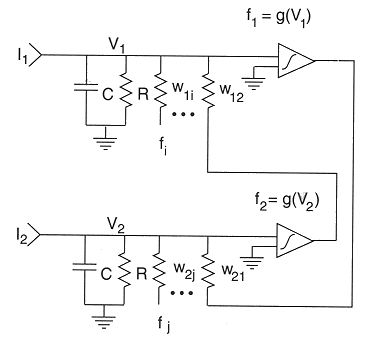


Next: About this document ...
Up: No Title
Previous: Modeling a Spiking Neuron
In a neural network composed of a large number (say, n) of synaptically
connected neurons, whether and how much a neuron is excited or inhibited depends
on the synaptic stimulations it receives from other neurons. The intensity of
each synaptic stimulation is in turn determined by (a) the level of excitation
(or inhibition) of the neuron transmitting the signal, represented by its firing
rate, and (b) the synaptic connectivity between the transmitting and receiving
neurons, represented by the weight between the two neurons. And the over
all evolution of the network, termed neurodynamics, can be described by
the flowing equation for the ith neuron in the network:
where weight wij represents the synaptic connectivity between the axon of
the jth neuron (transmitting) and the dentrite of the ith neuron (receiving),
fj is the firing rate of the jth neuron related to its membrane potential
Vj(t) by
fj(t)=g(Vj(t))
and Ii is the external current injected into the ith neuron, representing the
external stimulation. As mentioned before, if we treat g as dimensionless and
f as voltage, then the weight wij has the dimension of a conductance
(current/voltage), representing how easy it is for current to flow through the
synapse from the jth neuron to the ith neuron. And the larger wij, the more
the ith neuron is affected by the jth one.

As solving such a large simultaneous differential equation system (of n
equations) is in general very difficult, we further simplify the problem by
ignoring the temporal behavior of the system and concentrating on the magnitudes
of the output of a neuron as a function of the inputs from other neurons. The
membrane potential of the ith neuron in this much simplified model becomes
where ai represents the activation of the receiving neuron, xj represents
the signal intensity transmitted by the jth neuron (
 ,
assuming there are n of them), and wij represents the synaptic connectivity
from the jth neuron to the ith neuron.
If the activation level a is higher than the threshold, the neuron is excited
to generate action potentials which will travel along its axon to other neurons
down stream. The intensity of this output signal, represented by the firing rate,
is a function of the activation
,
assuming there are n of them), and wij represents the synaptic connectivity
from the jth neuron to the ith neuron.
If the activation level a is higher than the threshold, the neuron is excited
to generate action potentials which will travel along its axon to other neurons
down stream. The intensity of this output signal, represented by the firing rate,
is a function of the activation
where T represents the threshold, y the output signal (firing rate)
generated by the neuron, and f is a function such as the sigmoidal function
as discussed above.
This model is in the heart of many neural network algorithms. But note that all
these algorithms ignore the temporal behaviors of the system.



Next: About this document ...
Up: No Title
Previous: Modeling a Spiking Neuron
Ruye Wang
1999-09-20




